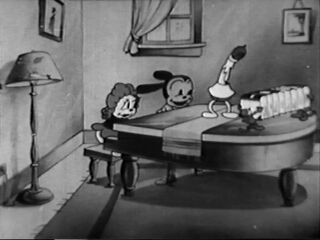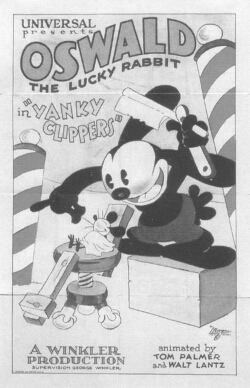
Pooch the Pup is a cartoon animal character, an anthropomorphic dog, appearing in Walter Lantz cartoons during the studio's black-and-white era. The character appeared in 13 shorts made in 1932 and 1933.

Five and Dime is a 1933 cartoon short by Walter Lantz Productions and stars Oswald the Lucky Rabbit. It is the 74th Oswald short produced by Lantz and the 125th overall.

Mechanical Man is a 1932 cartoon short by Walter Lantz that features Oswald the Lucky Rabbit. It is the 54th Oswald short by Lantz and the 107th in the entire series.

Henpecked is a 1930 animated short produced by Walter Lantz that features Oswald the Lucky Rabbit.

Yanky Clippers is a 1929 silent animated film starring Oswald the Lucky Rabbit. It is among the few shorts created during the Winkler period known to exist. The cartoon is also Oswald's last silent film.
Oil's Well is a 1929 short animated film starring Oswald the Lucky Rabbit and produced by Walter Lantz Productions. It is the 2nd Lantz Oswald film and the 54th in the entire series.
Spooks is a 1930 animated short subject produced by Walter Lantz and stars Oswald the Lucky Rabbit.

The Ginger Bread Boy is a 1934 animated short by Walter Lantz Productions and is among the many films of the Oswald the Lucky Rabbit series. The story mentioned in the cartoon is based on "The Gingerbread Man", published in St. Nicholas Magazine in 1875.

The Hunter is a 1931 short animated film by Walter Lantz Productions and stars Oswald the Lucky Rabbit. It is the 48th Oswald short of the Lantz era and the 100th in the entire series.
Grandma's Pet is an animated short film by Walter Lantz Productions and is part of the Oswald the Lucky Rabbit series. It is the 53rd Lantz Oswald cartoon and the 106th cartoon overall.

Carnival Capers is a 1932 animated short film featuring Oswald the Lucky Rabbit. It is the 65th Oswald cartoon by Walter Lantz Productions and the 117th in the entire series.

Wax Works is a 1934 animated short subject by Walter Lantz and features Oswald the Lucky Rabbit.
Mexico is a 1930 short animated film by Walter Lantz Productions and stars Oswald the Lucky Rabbit. The soundtrack of the cartoon was missing for many years, until the discovery of a sound print in 2013. Then in 2014 the soundtrack version of the cartoon was uploaded to YouTube, but was deleted due to the YouTube account being terminated. In 2015 and 2016 two other youtubers uploaded the soundtrack version of the cartoon.

The Winged Horse, also known by its reissue title of The Wing Horse, is a theatrical short cartoon by Walter Lantz Productions, featuring Oswald the Lucky Rabbit. It is the 59th Oswald short produced by Lantz's studio and the 112th to feature the character.

The Toy Shoppe is a 1934 short animated film produced by Walter Lantz Productions and is one of the many with the character Oswald the Lucky Rabbit. While the film was originally released in black and white, a colorized version was released in 1984.
The Hare Mail is a 1931 short animated film by Walter Lantz Productions and among the many featuring Oswald the Lucky Rabbit. The film is also one of the few where Mickey Rooney voiced the title character.
Mars is a 1930 short animated film in the Oswald the Lucky Rabbit series.
The Fireman is a short animated film distributed by Universal Pictures and stars Oswald the Lucky Rabbit. It is the 39th Oswald film by Walter Lantz Productions and the 95th in the entire series.
Wins Out is a 1932 animated short film by Walter Lantz Productions, featuring Oswald the Lucky Rabbit.

Chilly Con Carmen is a 1930 animated short film which was presented by Carl Laemmle and was produced by Walter Lantz, who would go on to produce Woody Woodpecker with his wife, Gracie Lantz. The film, which was animated by R. C. Hamilton, Tom Palmer and 'Bill' Nolan, features Oswald the Lucky Rabbit, as he attempts to engage in a game of bullfighting in order to charm a Mexican girl over his other girlfriend, Miss Hippo.












